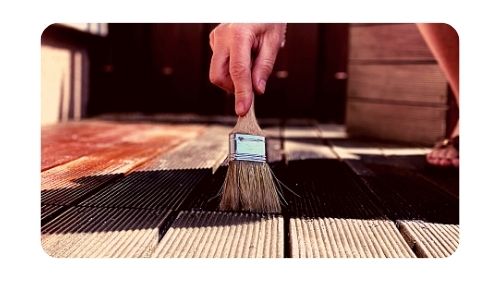Teak oil is some pretty special stuff.
Created originally as a finish for Teak wood furniture, this oil does a brilliant job at nourishing and enhancing otherwise drab-looking wood grain.
It’s made from a blend of Linseed oil, Tung oil, varnishes and mineral spirits. And this hodgepodge blend of natural oils and additives will soak deep into wood grain.
Which means that a few coats of Teak oil can protect lumber – right down to those fine wood fibers.
So, if Teak oil can do that, why would you even need to consider varnish instead?
Well, varnish will do a better job at preventing scratches and abrasions on the surface of wood. And this is due to the fact that it is more durable than Teak oil.
But, this isn’t the only practical reason why you’d choose varnish over teak oil (quick hint: appearances matter too)…

This post may contain affiliate links to products that we receive a commission for (at no additional cost to you). Learn more here.
First Off, Is Teak Oil A Good Wood Finish?
Teak oil is a great wood finish.
It soaks into wood, just like Linseed oil and Tung oil. But, thanks to its additional ingredients, Teak oil won’t take anywhere near as long to dry as a natural oil finishes does.
Related Post: How To Make Linseed Oil Dry Faster (What You Need To Know)
Does Teak Oil Waterproof Wood?
Teak oil will make wood water-repellent – so it offers waterproofing up to a point.
However, it needs to be stated that this oil finish is not a 100% waterproof sealant. Regardless, it still does everything you need a wood finish to do, in that it;
- A. Beautifies wood grain,
- B. Makes lumber water-repellent, and…
- C. Makes that timber much more bug-resistant.
Is Teak Oil A Drying Oil? Yes it is. This oil will dry and cure into a hard solid coat on the surface of wood.
But, as with most oil finishes, Teak oil can really darken wood after application.
Usually, this doesn’t pose a problem on brown or reddish lumber. Especially if you wanted to further deepen the color of a wooden surface.
Related Post: How To Darken Cherry Wood (What You Need To Know)
But if you apply Teak oil onto a pale grey wood, (such as Teak wood), this finish will turn wood from silver-grey to very dark-grey.
And Does Teak Oil Always Make Wood Darker?
Teak oil will always make wood darker, and that is due to it’s Linseed oil ingredient.
Linseed oil is not a great finish for very light colored wood types, because this particular oil injects a burnt-amber hue to lumber.
In other words, if you want wood to maintain its natural color, then avoid applying a Linseed oil finish to it.
Consequently, if you use Teak oil, you will get the same effect; which is that Teak oil will darken wooden surfaces.
In addition to that, direct UV rays will intensify things even further. So don’t be surprised if that Teak oil finish turns wooden decks from light grey to dull black.

So, Which One Is The Better Finish; Varnish Or Oil?
If you can only use one finish, and your choice is between varnish and teak oil, then choose varnish. Here’s why:
- Varnish will give wood a shine that’s more glossy than Teak oil.
- Varnish doesn’t darken wood anywhere near as much as Teak oil will.
- And varnish is more waterproof than Teak oil.
Side Note: You can use both varnish and teak oil together for extra waterproofing. Learn more by checking out our post here: Can You Varnish Over A Teak Oil Finish? (Best Practice Revealed)
What’s Not To Like About Varnish?
One of the main disadvantages of varnish is that it needs regular upkeep if it’s to be used on outdoor furniture or decking.
Varnish can succumb quite harshly to weathering. It will peel, and even crack, if it is not maintained. Plus, once those small cracks form, water will seep in under the varnish and cause a lot of damage.
So, just be aware that using this sealer is far from a one-and-done job. That varnish coat will need sanding/reapplication at least once a year.
Related Post: Can You Varnish Over Wax Finished Furniture?
That’s not to say that Teak oil won’t require a fair amount of maintenance too. It absolutely does. If you use Teak oil on outdoor surfaces, then be prepared to reapply it every 3-6 months.
Another Quick Side Note: It is worth pointing out here that if you’re thinking about applying teak oil or varnish onto teak wood specifically, best practice is that you don’t.
Teak wood is a dense oily wood. And it doesn’t need an oil finish, varnish, or most any kind of sealer.
To learn more about why this popular boat-building material doesn’t need oil/varnish, check out our post here: Can You Apply Lemon Oil On A Teak Wood Surface?
To Sum Up…
If you are sealing anything besides a Teak wood surface: Use varnish. It is more durable and requires less upkeep than a Teak oil finish.
If you are sealing a Teak wood surface: Use neither. High-quality Teak wood doesn’t need any kind of water-repellent varnish coat or oil treatment.



